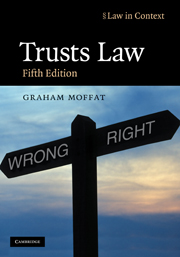Book contents
- Frontmatter
- Contents
- Preface to the fifth edition
- Acknowledgments
- Table of abbreviations
- Useful websites
- Table of statutes
- Table of statutory instruments
- Table of cases
- 1 Trusts introduced
- 2 The evolution of the private express trust
- 3 Taxation, wealth-holding and the private trust
- 4 Creating the trust – I
- 5 Creating the trust – II
- 6 Trusts and public policy
- 7 Flexibility in relation to beneficial entitlement
- 8 The taxation of private trusts
- 9 An introduction to trustees and trusteeship
- 10 Aspects of the management of trusts
- 11 Trusteeship, control and breach of trust
- 12 Implied trusts and the family home
- 13 Trusts in commerce I: occupational pension schemes
- 14 Trusts in commerce II: commerce and equitable remedies
- 15 Trusts in commerce III: commerce, credit and the trust
- 16 Trusts in commerce IV: fiduciary relationships, commerce and the trust
- 17 Trust, contract and unincorporated associations
- 18 An introduction to the law of charity
- 19 A legal definition of ‘charity’
- 20 The regulation of charities
- Index
15 - Trusts in commerce III: commerce, credit and the trust
- Frontmatter
- Contents
- Preface to the fifth edition
- Acknowledgments
- Table of abbreviations
- Useful websites
- Table of statutes
- Table of statutory instruments
- Table of cases
- 1 Trusts introduced
- 2 The evolution of the private express trust
- 3 Taxation, wealth-holding and the private trust
- 4 Creating the trust – I
- 5 Creating the trust – II
- 6 Trusts and public policy
- 7 Flexibility in relation to beneficial entitlement
- 8 The taxation of private trusts
- 9 An introduction to trustees and trusteeship
- 10 Aspects of the management of trusts
- 11 Trusteeship, control and breach of trust
- 12 Implied trusts and the family home
- 13 Trusts in commerce I: occupational pension schemes
- 14 Trusts in commerce II: commerce and equitable remedies
- 15 Trusts in commerce III: commerce, credit and the trust
- 16 Trusts in commerce IV: fiduciary relationships, commerce and the trust
- 17 Trust, contract and unincorporated associations
- 18 An introduction to the law of charity
- 19 A legal definition of ‘charity’
- 20 The regulation of charities
- Index
Summary
Introduction
We have seen in Chapters 11 and 14 how the determination of the courts to protect the interest of the beneficiaries in the event of trustee insolvency or misconduct was manifested in two ways in particular: (i) the separation of trust property from the insolvent's own assets; and (ii) the provision of the process of equitable tracing. Thus, property held by an insolvent or bankrupt person or company in trust for another is, with one exception, not available to the liquidator or trustee in bankruptcy to meet the claims of creditors. The exception is where an insolvent trustee has outlaid its own moneys in satisfaction of the trust's liabilities. A right of indemnity arises against trust assets for such liabilities satisfied on the trust's behalf (eg in running a business of the trust). This gives the trustee a proprietary interest in the trust assets, which may pass to a trustee in bankruptcy or liquidator for the benefit of creditors (see generally Hayton and Marshall at pp 693–703). In certain rare circumstances it has been held that property held on trust may be available to the liquidator to cover its costs if the insolvent's other assets are insufficient (see Chapter 14, p 740). The reasoning behind the fundamental principle that the insolvent's property does not include trust property is clear enough: trust property is beneficially owned not by the insolvent or bankrupt trustee, but by the beneficiaries.
- Type
- Chapter
- Information
- Trusts LawText and Materials, pp. 795 - 832Publisher: Cambridge University PressPrint publication year: 2009



